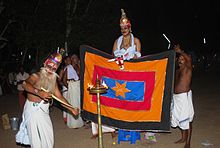- Mudiyett
-
Mudiyettu Mudiyettu is ritualistic dance drama performed after the harvest of summer crops in Kerala.In 2010, Mudiyettu included in UNESCO Intangible Cultural Heritage Lists. It is in the Representative List of the Intangible Cultural Heritage of Humanity of UNESCO
Contents
Background
Mudiyettu is a ritual dance drama from Kerala based on the mythological tale of a battle between the goddess Kali and the demon Darika. It is a community ritual in which the entire village participates. After the summer crops have been harvested, the villagers reach the temple in the early morning on an appointed day. Mudiyettu performers purify themselves through fasting and prayer, then draw a huge image of goddess Kali, called as kalam, on the temple floor with coloured powders, wherein the spirit of the goddess is invoked. This prepares the ground for the lively enactment to follow, in which the divine sage Narada importunes Shiva to contain the demon Darika, who is immune to defeat by mortals. Shiva instead commands that Darika will die at the hand of the goddess Kali. Mudiyettu is performed annually in ‘Bhagavati Kavus’, the temples of the goddess, in different villages along the rivers Chalakkudy Puzha, Periyar and Moovattupuzha. The dance is performed by members of the Ezhavathy community, who were once priests of many temples in Kerala. Mutual cooperation and collective participation of each caste in the ritual instills and strengthens common identity and mutual bonding in the community. Responsibility for its transmission lies with the elders and senior performers, who engage the younger generation as apprentices during the course of the performance. Mudiyettu serves as an important cultural site for transmission of traditional values, ethics, moral codes and aesthetic norms of the community to the next generation, thereby ensuring its continuity and relevance in present times.[citation needed]
It is a form of bhagavathi or bhadrakali cult.The dance is performed by a set of people known as Kuruppanmar, mainly in Bhadrakali temple.Chenda and elathalam are the instruments used.[citation needed]
Kalampattu
This is traditionally a temple art known as Bhagavathyppattu or Bhadrakalippattu. It is also like 'Mudiyettu'.The figure of Devi is developed with the judicious combination of various colors made from roots and leaves and grains. Usually a particular sect brahmin called Kuruppanmar has inherent devotional skill in this art.
See also
- Arts of Kerala
- Kerala Folklore Academy
References
- Kerala Charithram ,the book written by Kumarakom Sankunni Menon
- Pazhayannurtemple
- Thirumandhamkunnutemple
- UNESCO recognition a boost to Mudiyettu-Hindu News
- Mudiyettu, ritual theatre and dance drama of Kerala
External links
Categories:- Dances of India
- Arts of Kerala
- Kerala stubs
- Indian dance stubs
Wikimedia Foundation. 2010.

